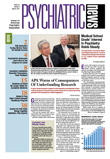Maintaining close contact with patients after they have had a stroke may be as important as prescribing medications to treat the depression that may follow, according to researchers at Indiana University School of Medicine and the Indianapolis Veterans Affairs Medical Center.
About one-third of stroke survivors are diagnosed with depression, and they tend to recover more slowly and do more poorly in daily activities, even after accounting for stroke severity. Research into poststroke depression (PSD), however, has been insufficient to clarify the benefits of treatment for PSD.
Depression may follow stroke for several reasons, explained Robert Robinson, M.D., chair and Paul W. Penningroth Professor of Psychiatry at the University of Iowa, in an interview. There is some evidence that PSD is related to the area of the brain injured by the stroke, suggesting that the stroke itself is involved in the origin of the depression, said Robinson, who was not involved with the Indiana study. Incidence of depression may also reflect a family history of the disorder or a reaction to the disability engendered by the stroke, he said.
The Indiana study found that an intensive combination of education, treatment, and follow-up improved response to treatment and remission rates, compared with patients getting usual care.
“PSD is as responsive to treatment as is depression associated with other serious medical conditions,” wrote Linda S. Williams, M.D., an associate professor of neurology at Indiana University, and colleagues in the March Stroke.
The researchers studied 188 depressed patients who had survived an ischemic stroke. All had been screened with the PHQ-9 depression scale and tested with the Hamilton Depression Inventor y (HAM-D). About 72 percent of the intervention patients and 75 percent of the control group had major depression; the rest had minor depression. Half the patients were randomized to receive usual care and half the intervention. There were no significant differences in stroke, HAM-D, or PHQ-9 scores between the two groups.
Usual-care patients received baseline and telephone sessions alerting them to recognize and monitor stroke symptoms.
The intervention group first received a 20-minute psychoeducat ional session informing the stroke survivors and their families about depression, said Williams in an interview. Patients then began antidepressant treatment, typically with the SSRIs paroxetine or sertraline, although the physician could use another antidepressant. If patients were unresponsive or experienced significant side effects, the algorithm prompted a change to venlafaxine or another antidepressant if preferred. Some patients in the intervention discontinued their medication during the first 12 weeks.
For the third element of the intervention, nurse care managers telephoned each patient twice a month using a standard script to evaluate depression symptoms, side effects, and adherence. Each case was discussed in a weekly care-management meeting with study physicians, and medication was adjusted as needed.
The intervention lasted for 12 weeks. Six- and 12-week assessments of depression were performed by a researcher not involved in care management and blinded to treatment allocation.
After 12 weeks, 51 percent of the intervention subjects responded significantly to treatment, meaning they were more likely to record either a HAM-D score of 8 or less (the standard for remission), or a 50 percent reduction from baseline, compared with 30 percent of the usual-care patients.
Also, 39 percent of intervention patients achieved depression remission versus 23 percent of usual-care subjects.
The results should be considered conservative estimates of the treatment effect for two reasons, said the authors. For one thing, physicians prescribed antidepressants to 56 percent of patients in the usual-care group. Also, both groups received an equal number of telephone calls, which eliminated any differences caused by the effects of attention to patients on the part of medical professionals.
Adherence to treatment is a major issue, especially among an older, stroke-prone population, said Robinson.
“The recent CATIE and STAR*D trials found that patients often stopped taking their medications after a few months,” he said. So someone needs to encourage patients to take their pills, and the involvement of the treating team in this study probably made the difference.
“When they get calls from the project nurses, I think patients feel that someone is interested in them and cares about what happens to them,” said Robinson.
While the results of the Indiana trial are encouraging, Robinson remains concerned about the 44 percent of patients in the usual-care group not taking antidepressants.
“Hopefully, no patient would be denied treatment with antidepressants, since treatment improves physical and cognitive recovery from stroke,” he said.
There were reasons why not all usual-care patients were on antidepressants, explained study co-author Kurt Kroenke, M.D., professor of medicine in the School of Medicine and senior scientist at the Regenstrief Institute for Health Care at Indiana University, Indianapolis, in an interview. As noted above, about 1 in 4 of all patients endorsed depressive symptoms but did not have major depression. Some in the control group refused antidepressant treatment.
“The usual-care patients were treated at the discretion of their provider,” added Williams. “We didn't mandate that they be treated, as that wouldn't be usual care. So providers may have decided not to treat, or they may have suggested treatment but the patient declined to take medication.
We don't know the details of these interactions.”
“Our results also suggest that although some stroke survivors may respond to antidepressants alone, the addition of patient activation and telephone-based treatment monitoring that includes dose adjustment and medication changes may further enhance the successful treatment of PSD,” concluded the researchers. “These data demonstrate that PSD can be effectively treated with standard antidepressant algorithms based on current evidence-based guidelines for depression treatment.”
